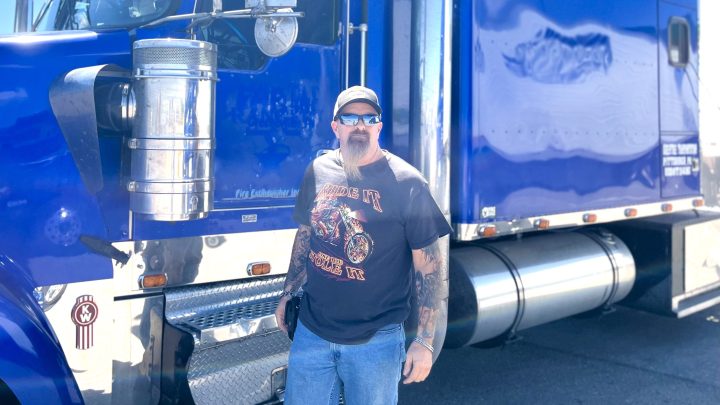
Big rig trucking needs to go green to meet climate goals, but charging is a challenge
Big rig trucking needs to go green to meet climate goals, but charging is a challenge

The Petro Travel Center off Interstate 80 in Laramie, Wyoming, is like a gas station on steroids. Truck drivers stop here to grab a meal, fix a tie-down or refuel.
Long-hauler Richard Summers was passing through on his way from Portland, Oregon, to Chesapeake, Virginia. He’s been driving trucks for 30 years and likes life on the road.
“I just enjoy traveling and getting paid to see everything nobody else gets to,” he said. “My dad was a trucker. My grandpa was a trucker. My cousins are truckers. This is just in the family blood, and it’s hard to get out of it.”
Summers likes to repeat the phrase “If you bought it, a truck brought it” because it highlights how important long-haul drivers are to the U.S. economy. Trucks move almost 73% of domestic freight by weight, according to the American Trucking Associations, and they collectively traveled over 300 billion miles in 2021.
But long-haul rigs also contribute to global warming. Medium- and heavy-duty trucks, which comprise just 5% of vehicles on the road, are responsible for about a quarter of transportation emissions.
So, there is now a push for this sector to go green, and some companies are ready to capitalize on that.
At a recent event outside Reno, Nevada, Tesla CEO Elon Musk unveiled the Semi, an electric vehicle that can tow tens of thousands of pounds with a range up to 500 miles.
“If you’re a truck driver and you want the most badass rig on the road, this is it,” he said.
A few companies have already bought Semis, including Pepsi. Other manufacturers, like Peterbilt and Volvo, also sell electric rigs.
Bernd Heid, a senior partner with research firm McKinsey & Co., said electric trucks will likely get cheaper and more accessible over time. Plus, maintenance and fuel costs are typically lower than those for conventionally powered trucks, and that can make a difference for vehicles that travel so many miles.
“If you do a lot of mileage, you have more chances to amortize the high investment into, for example, a fuel-cell truck. So I think [for] exactly this coast-to-coast trucking, if you do the math with a fuel-cell electric truck versus a diesel truck, at a certain point that will break even,” Heid said.
But some truckers are not convinced that electric is the way to go — including Richard Summers.
“It’s just not feasible right now. We don’t have the technology. We’re getting there. Just not ready yet,” he said. “And personally, I feel by the time we do, we’ll come up with something better.”
Electric big rigs can cost hundreds of thousands of dollars, which is usually two or three times more than diesel trucks. The batteries are also heavy, which means drivers can’t carry as much cargo. And, although the federal government is spending billions to build chargers, there aren’t enough yet.
Lewie Pugh, executive vice president of the Owner-Operator Independent Drivers Association, said many of his members are concerned about a lack of infrastructure. Additionally, charging can take anywhere from 30 minutes to eight hours, depending on which chargers are available, as opposed to about 15 minutes fueling at the pump.
“There’s still a lot of unknown factors when it comes to EVs, especially in the long-haul sector,” Pugh said. “I don’t see how any trucker can go out there and buy an electric truck tomorrow and replace his internal combustion engine.”
Bernd Heid said the U.S. must build about 250,000 charging outlets by 2035 to meet basic infrastructure needs for zero-emissions trucking. He also advocates for more hydrogen refueling stations — another clean energy option — to speed up the transition.
The Joe Biden administration and some states want to phase out emissions from heavy-duty vehicles in the next couple of decades. They’re trying to incentivize truckers to switch with clean air mandates, tax breaks or another method.
Pugh understands that the switch to electric is happening but doesn’t want the government to force it before it’s practical.
“When you’re talking [about] our national supply chain, you can’t just say, ‘Oh, we’ll figure it out,’” he said.
Pugh wants to be sure these new trucks and the charging systems work to get his drivers — and the goods they transport — where they need to go.
There’s a lot happening in the world. Through it all, Marketplace is here for you.
You rely on Marketplace to break down the world’s events and tell you how it affects you in a fact-based, approachable way. We rely on your financial support to keep making that possible.
Your donation today powers the independent journalism that you rely on. For just $5/month, you can help sustain Marketplace so we can keep reporting on the things that matter to you.

















